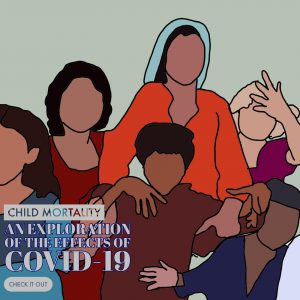An Exploration of the Effects of COVID-19 on Child Mortality
 As the world population is beginning to see the long term impacts of COVID-19, it is worth taking a look at its impact on the lives of many children living in lower-income countries. Much like any pandemic, different groups of people in different regions worldwide are affected in different ways. With SARS and Ebola, we saw the impact on child mortality mostly indirectly, and that is no different from the current COVID-19 pandemic. We are seeing the direct impact of young children contracting the virus and sadly dying as a result. However, we also see deaths as a result of lack of regular immunizations, death as a result of limited access to medical care and supplies as well as a possible long term impact such as the impact on child wellbeing when they lose a caregiver, education and other types of disruptions.
As the world population is beginning to see the long term impacts of COVID-19, it is worth taking a look at its impact on the lives of many children living in lower-income countries. Much like any pandemic, different groups of people in different regions worldwide are affected in different ways. With SARS and Ebola, we saw the impact on child mortality mostly indirectly, and that is no different from the current COVID-19 pandemic. We are seeing the direct impact of young children contracting the virus and sadly dying as a result. However, we also see deaths as a result of lack of regular immunizations, death as a result of limited access to medical care and supplies as well as a possible long term impact such as the impact on child wellbeing when they lose a caregiver, education and other types of disruptions.
According to an article written in the New York Times, many public health officials fear that deaths as a result of diseases such as cholera, rotavirus, and diphtheria could outnumber deaths as a result of COVID-19 itself. A study conducted of 129 lower and middle-income nations showed that at least 68 of them had experienced disruption to their regular vaccination services. Countries like Chad, Ethiopia, Pakistan, and the Democratic Republic of Congo have experienced disruptions to their measles or polio programs. The reason for this problem can stem from two different angles. The first one is a shortage. Reports show that over 80% of the flights to nations in Africa that deliver vaccines and syringes and other medical supplies have been canceled. As a result, healthcare workers are hesitant to administer care due to the lack of medical resources as well as protective equipment. The other side of this is that people are afraid to seek medical care. Many parents fear to take their children to get vaccinated because they do not want to risk catching the Coronavirus. The lack of children receiving immunizations regardless of the reason has led to a rise in preventable diseases and could end up killing more people.
Another impact COVID-19 has on countries worldwide, but more specifically, lower-income countries is a redirection of funding and resources towards treating and preventing the virus. The redirection of funding is problematic for several reasons. COVID-19 poses a threat to life-saving interventions that are usually accessible to the populations. A study published on May 12, 2020, examined a wide range of outcomes regarding disruption to the healthcare system in light of COVID-19. The purpose was to look at how that disruption, whether due to the availability of healthcare workers, or the demand for health care services, affects the child and maternal mortality rates. They found that in any of the many different scenarios they accounted for, there was a significant rise in child and maternal mortality. Although the study does not present itself as a prediction of the future, it serves as a model of possible and very plausible outcomes due to disruptions to the healthcare system as a result of the current pandemic. What is shown in the study is that the minimization of these disruptions will reduce the percentage of increase when it comes to child and maternal mortality.
Lastly, COVID-19, to our knowledge, disproportionately affects the lifestyle of low-income families in nations worldwide. It is also being suggested that the most impoverished nations will bare the impact on a more long term basis. Many as a result of the pandemic have lost their jobs. For people living paycheck to paycheck, this is an incredible step back. Many families are falling in poverty, and for those already suffering, it has made it much harder to survive. According to data from the United Nations, the pandemic could push up to 106 million households into poverty. This loss of income can cause the inability to afford necessities, including nutritious food and clean water. Additionally, the closure of school has affected 1.5 billion children worldwide. Many schools have resorted to internet-based learning, but for students from lower-income families, that is not an option. The lack of education could yield long term effects on the population’s maternal education, which is an indicator of child mortality.
Many issues COVID-19 has brought to light were seen before during the SARs and Ebola crisis. Although each new outbreak brings new challenges, the best way to get ahead of them is by educating ourselves and genuinely understanding the immediate evident impacts but also those that are much harder to see and identify. We must treat the aftermath of this pandemic with just as much urgency and attention as we treat the pandemic itself.
